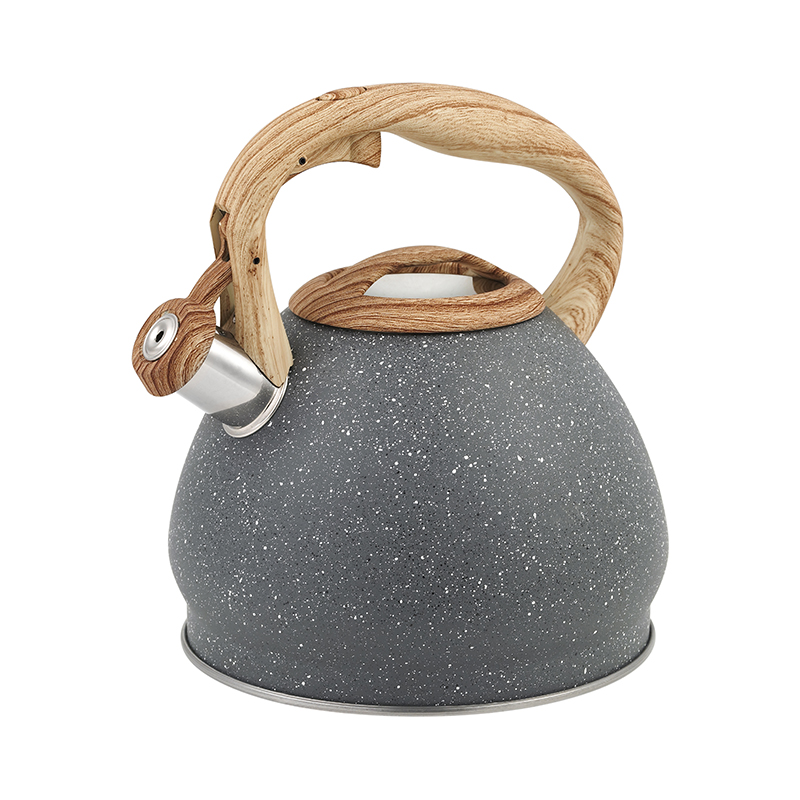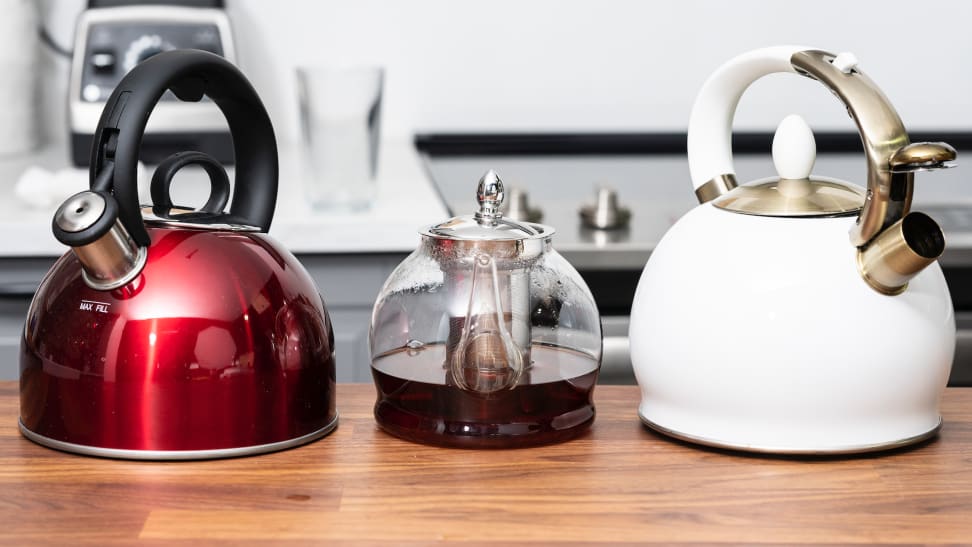Are you looking for a whistling tea kettle that not only looks attractive but also can stay rust-free and last for years? Then a stainless steel whistling tea kettle is exactly what you need.
With this guide, you’ll learn all the advantages of using a stainless steel kettle and why it will be the perfect fit for your kitchen. So, let’s get started!
Stainless steel whistling tea kettles have become increasingly popular in the last few years. Not only do they look great, but they also provide several distinct advantages over traditional kettles. In this complete guide, we will take a closer look at some of the benefits that make stainless steel whistling tea kettles so appealing.
For starters, a stainless steel whistling tea kettle is much easier to clean than other types of kettles. Because of its smooth surface, there is less chance for residue or mineral deposits to build up inside the kettle over time. As a result, you’ll have an easier time cleaning it and keeping it hygienic compared to other types of kettles that require more frequent scrubbing and maintenance.
Another benefit of using a stainless steel whistling tea kettle is that it’s made with non-reactive materials which makes it ideal for boiling water for teas and other beverages. Since the metals used in these tea kettles don’t react with acids such as those found in citrus fruits like lemon or lime juice, you won’t have to worry about any unpleasant metallic tastes infiltrating your beverage when boiling water in one of these teapots.
Finally, these kinds of tea kettles are perfect for people who want an easy way to boil water without having to use electricity or gas stoves. As long as there is an available flame source such as on a camping stove or gas burner, you can easily boil water using one of these whistling teapots without any hassle or bothersome cords getting in the way.
How to choose the right stainless steel whistling tea kettle
Making the decision about which stainless steel whistling tea kettle to buy can be a challenge. While price is certainly a factor, there are several other features that make each model unique. It’s important to consider what type of handle would work best for you, the size of the kettle, and whether you need additional features such as an automatic shut-off function or a whistle that is easily heard. Here are some tips to help you find the best stainless steel whistling tea kettle for your needs.
Handle Style: Most stainless steel whistling tea kettles feature a switchable handle; this allows you to pick and rotate the optimal angle for filling and pouring your water. Other models have a bail-type handle that hooks onto the top of the pot so it doesn’t over balance when pouring. There are also kettles with stay-cool handles made out of plastic or rubber material for easy gripping and maneuvering even when hot.
Size: Smaller capacity kettles generally heat up faster, but if you need enough for bigger groups then larger models will suit you better (2-4 Liters). For travel use, look for smaller capacities kettles that can fit in tight spaces. You should also consider whether any special accessories like filters or detachable lids are necessary with your choice of teapot size.
Extra Features: Automatic shut off technology takes away all worry regarding timing how long to boil water so it’s safe only by simple turning on/off switch. Additionally, some models feature built-in water level indicators so you don’t have to measure manually before each filling session or guess at it during use; this is especially helpful if frequent refills are needed throughout your brewing process! Last but not least look at whether a loud whistle or subtle one is desired from both quality control perspective (to alert user it’s finished) as well convenience aspect (not waking up everyone in house while boiling).
Capacity and size
When choosing a stainless steel whistling tea kettle, capacity and size are key variables to consider as they affect the ease of heating water and pouring the hot water into any number of vessels or containers. Most kitchens are equipped with countertops sized for average pots, which makes finding a pot or kettle that fits ideal.
Regular kettles typically hold between 3-4L while teapots generally hold 2-3L. The capacity is dependant on the size and inversely proportional; a larger diameter kettle will have less capacity then one with smaller diameter. Furthermore, it is important to assess how frequently you need to fill and refill your kettle as well as who will use it; how many people does it need to serve and so on. If your family drinks an abundance of tea then larger capacity may be needed over smaller 1L whistling kettles.
Additionally, some may prefer a minimalistic design with height in mind; this is where an electric kettle may provide convenience, selecting the desired volume without having concern for surface space.
Type of handle and spout
When considering which type of tea kettle to buy, pay attention to the handle and spout. Different types of tea kettles come with different shapes of handles and spouts, so you’ll need to consider your own kitchen and brewing preferences before deciding what type of handle and spout are best for you.
Stainless steel whistling tea kettles generally come with two main types of handles — a medium or long loop handle, or a gooseneck handle. The medium-length loop handle offers an easy grip when pouring, while the gooseneck makes it easier to pour slowly or in small increments. Both types help make sure that hot water is safely pulled away from your body as you pour.
The spout also varies depending on which type of stainless steel whistling tea kettle you opt for. Traditional models usually have short round nozzles that release water quickly when tipped over a cup or teapot; however, there are now more modern designs with narrow gooseneck nozzles ideal for accurately controlling the speed of pouring. When selecting a teakettle remember not all are interchangeable so ensure you get one that best meets your needs!
Compatibility with stove type
When selecting a stainless steel whistling tea kettle, it is important to consider what type of stove you will be using with the kettle. If purchasing a traditional-style whistling tea kettle, it is best for use on an electric or gas range. Many models work well on induction burners as well, but check the product details before buying to ensure compatibility.
Additionally, some models are made specifically for use with induction burners and may have special features that help distribute heat more evenly or quickly so you can get your water boiling even faster.
Additional features (e.g. removable lid, strainer)
Stainless steel whistling tea kettles offer not only visual appeal, but also many convenience features. One of the most common additional features is a removable lid which can be easily opened and closed without removing the entire lid. The benefit of this feature is that it allows you to conveniently fill and pour the tea kettle without having to remove the lid each time.
Another great feature is a strainer to catch any loose debris or leaves while pouring through the spout. This helps keep your beverage from becoming contaminated with particles from previous steepings and keeps it free from bitterness. Many stainless steel whistling tea kettles also come with cool-touch handles for easy carrying, so that you don’t have to worry about burning your hands during use.
Heating elements often come equipped on stainless steel tea kettles so that you can conveniently control the temperature of your water for steeping teas at their ideal temperatures for maximum flavor extraction. This electric element should be housed in one portion of the kettle body, allowing you to safely heat up water without risk of unexpected exposure or electric shock hazards if handled incorrectly.

III. Care and maintenance of a stainless steel whistling tea kettle
When you buy a stainless steel whistling tea kettle, be sure to check the product information to ensure that it is safe for use on the type of heat source you intend to use. Proper use and maintenance of your kettle can help extend its life.
To properly care for and maintain your stainless steel whistling tea kettle:
- Make sure to clean your tea kettle regularly with mild soapy water and rinse thoroughly in order to remove any build-up from previous uses. Avoid using harsh detergents or metal scrub pads which may damage the finish of your stainless steel kettle;
- Fill the kettle no more than two-thirds full when boiling, as overfilling may cause boiling water to seep out through the spout. This can cause injury or burns;
- To avoid rusting, never place an empty tea kettle on a flame or heating element.; allow it cool down before washing and refilling;
- After each use, keep a clean cloth nearby to wipe down the outside and spout; this will help prevent discoloration due to oxidization;
- Do not leave water in your teakettle for extended periods of time since this can lead to corrosion and discoloration, particularly if the water has high mineral content.;
- Do not leave sugary drinks or acidic liquids in your teakettle overnight.; Use only plain water for boiling purposes.;
- To avoid developing bacteria, dry off all visible moisture or wet surfaces immediately after each use;
- Occasionally refill your teakettle with white vinegar mixed with equal parts of hot water.; Allow it remain sit overnight then rinse thoroughly with warm water before using again. This technique will help sanitize and remove any mineral deposits which might have formed over time.
Regular cleaning and descaling
Regular cleaning and descaling are important components of maintenance for a stainless steel whistling tea kettle. To clean the surface of the tea kettle, use warm, soapy water. Make sure to rinse and dry the kettle after use to prevent any water spots from forming on it.
Additionally, scale can build up inside the tea kettle from hard water, mineral deposits or sediment which should be removed by descaling periodically. This can be easily done by filling the stainless steel tea kettle with a mixture of vinegar and water and bring it to a boil. Afterwards, dump out the liquid mixture and rinse it with warm, soapy water until all traces of descale or residue is gone. Finally make sure to thoroughly dry before using again.
Proper storage and handling
Caring properly for your stainless steel whistling kettle is not only important for its aesthetics, but also for its overall longevity. To ensure that your steel tea kettle will stand up to years of use and abuse, it is important to store it in a clean and dry environment, and maintain with regular cleaning routines. Here are some tips to keep in mind when handling and storing your steel tea kettle:
-Make sure that the inside of the kettle is completely dry before popping it away in an enclosed area. Any trace moisture can cause bacteria growth over time.
– Regularly inspect all rubber parts of your steel tea kettle for tightness and signs of decay, as these are known sources of leaks over time.
– Ensure that all surfaces remain rust-free – if left unchecked, rust can cause major structural issues. Use a few drops of oil or lubricant to keep all moving parts working efficiently.
Tips for avoiding common issues (e.g. mineral buildup, discoloration)
Although stainless steel whistling tea kettles have a variety of benefits, such as rust-resistance and durability, there are some common issues that can arise with prolonged use if not properly maintained.
Rusting is one of the most common of these issues, as it can be caused by contact with acidic liquids like lemon juice. To avoid this, ensure that your tea kettle is not exposed to any acidic substances and that it is thoroughly cleaned on a regular basis.
Another issue to watch out for is mineral buildup. This commonly occurs with hard water, which contains large amounts of minerals such as magnesium and calcium. If your tea kettle uses hard water, minerals like these can build up in the base and cause discoloration as well as poor water flow or even clogs in the spout or handle.
To prevent this from happening, descale your tea kettle occasionally with a gentle descaler solution – options range from store-bought products to natural mixtures made from ingredients such as lemon juice and vinegar – or use filtered or distilled water for maximum safety.
Conclusion
At the end of the day, all that really matters is what you prefer. Some people may prefer whistling tea kettles made with copper, while others prefer stainless steel. This guide hopefully showed you some of the pros and cons of each material, so that you can make an informed decision.
Keep in mind that a whistling tea kettle offers more than just coffee, and it can be used to steep teas or even use for other hot beverage making endeavors. Beyond choosing between copper and stainless steel kettles, be sure to consider reviews and prices before making a final decision.
FAQ’s
Is stainless steel good for a tea kettle?
- Yes, stainless steel is a good material for a tea kettle as it is durable, easy to clean, and does not rust or corrode easily.
What are the advantages of a whistling kettle?
- The main advantage of a whistling kettle is that it signals when the water has reached boiling point, which can prevent overheating and damage to the kettle. It also alerts you when the water is ready, making it a convenient and practical option.
What is the best material for a water kettle?
- The best material for a water kettle depends on personal preference, but some popular options include stainless steel, glass, and ceramic. Each has its own advantages and disadvantages, so it’s important to consider factors such as durability, heat retention, and ease of cleaning.
What is the advantage of stainless steel kettle?
- Stainless steel kettles are durable, rust-resistant, easy to clean, and can maintain heat for a longer period of time than other materials. They also tend to have a sleek and modern design, making them a popular choice for many households.
Does stainless steel affect taste of tea?
- No, stainless steel does not affect the taste of tea as it is non-reactive and does not release any harmful chemicals into the water. It is a safe and practical material for tea kettles.
What is the healthiest kettle for water?
- Glass kettles are often considered the healthiest option for boiling water, as they do not release any harmful chemicals into the water and are easy to clean. Stainless steel and ceramic are also good options.
What is the safest material for a tea kettle?
- The safest material for a tea kettle is one that does not contain any harmful chemicals or toxins, such as BPA or lead. Glass, stainless steel, and ceramic are all considered safe options for tea kettles.
What type of tea kettle is best?
- The best type of tea kettle depends on personal preference, but some popular options include stovetop kettles, electric kettles, and whistling kettles. Each has its own advantages and disadvantages, so it’s important to consider factors such as convenience, speed, and ease of use.
Is stainless steel good for boiling?
- Yes, stainless steel is a good material for boiling as it is durable, non-reactive, and can maintain heat for a longer period of time than other materials. It is a safe and practical option for boiling water and other liquids.
What is the best metal for a kettle?
- Stainless steel is often considered the best metal for a kettle as it is durable, easy to clean, and does not rust or corrode easily. Copper and aluminum are also popular options, but they may require more maintenance and can be more expensive.
See Also-
- Best whistling tea kettle
- Best non toxic electric kettle
- Best kettle for chemex
- Best glass tea kettle
- Best electric pour over kettle

